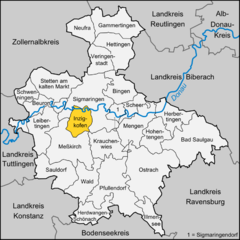You can help expand this article with text translated from the corresponding article in German. (February 2009) Click [show] for important translation instructions.
|
Inzigkofen | |
|---|---|
Location of Inzigkofen within Sigmaringen district  | |
| Coordinates: 48°4′18″N 9°10′32″E / 48.07167°N 9.17556°E | |
| Country | Germany |
| State | Baden-Württemberg |
| Admin. region | Tübingen |
| District | Sigmaringen |
| Government | |
| • Mayor (2020–28) | Bernd Gombold[1] |
| Area | |
| • Total | 28.76 km2 (11.10 sq mi) |
| Elevation | 590 m (1,940 ft) |
| Population (2022-12-31)[2] | |
| • Total | 2,975 |
| • Density | 100/km2 (270/sq mi) |
| Time zone | UTC+01:00 (CET) |
| • Summer (DST) | UTC+02:00 (CEST) |
| Postal codes | 72514 |
| Dialling codes | 07571 |
| Vehicle registration | SIG |
| Website | www.inzigkofen.de |

Inzigkofen is a municipality in the district of Sigmaringen in Baden-Württemberg in Germany. Historically, it is part of the Swabian north Alpine foreland basin.[3]
It consists of three districts:
| Coat of Arms |
District (Teilort) |
Population[4] | Area[4] |
|---|---|---|---|
| Inzigkofen with Nickhof und Pault |
1372 | 931 hectares (2,300 acres) | |
| Engelswies | 611 | 749 hectares (1,850 acres) | |
| Vilsingen with Dietfurt |
845 | 1,196 hectares (2,960 acres) |
Within Engelswies is the now-abandoned Talsberg quarry, known for its fossiliferous layers, and the site of evidence of the oldest Eurasian hominoids; a molar tooth found there in June 1973 was reported in June 2011 to have been "dated with relative precision at 17 to 17.1 Ma" (million years ago).[3]
- ^ Aktuelle Wahlergebnisse, Staatsanzeiger, accessed 15 September 2021.
- ^ "Bevölkerung nach Nationalität und Geschlecht am 31. Dezember 2022" [Population by nationality and sex as of December 31, 2022] (CSV) (in German). Statistisches Landesamt Baden-Württemberg. June 2023.
- ^ a b "Oldest Eurasian Hominoids Lived in Swabia: Molar Tooth Dated at 17 Million Years Old". Science Daily. June 22, 2011. Retrieved 2011-06-23.
- ^ a b Sonja Köser, Inzigkofen Community Office, 18 January 2011.


